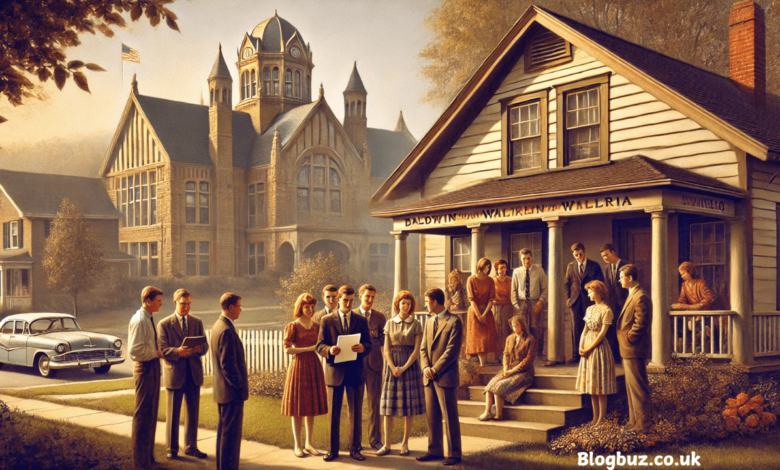City of Berea Ohio Bans Greek Houses 1960s: A Historical Perspective

The 1960s were a transformative decade for American colleges and universities, marked by significant social and cultural shifts. One of the lesser-known yet impactful decisions during this period was the City of Berea, Ohio’s ban on Greek houses. Home to Baldwin Wallace University (BWU), Berea took a bold stance against fraternity and sorority housing, reshaping campus life for generations to come. This article explores the historical context, reasons behind the ban, its consequences, and its long-term effects on Greek life at Baldwin Wallace University.
Historical Context: The Role of Greek Life in the 1960s
Greek-letter organizations, commonly known as fraternities and sororities, have been integral to American college culture since the early 19th century. By the mid-20th century, these organizations were well established at Baldwin Wallace University, fostering social connections, leadership opportunities, and lifelong friendships. However, the 1960s also saw increasing scrutiny of Greek life due to concerns over hazing, excessive partying, and the potential for exclusionary practices.
Many communities and universities reassessed their relationship with Greek organizations during this period, leading to stricter regulations. The decision by the City of Berea to ban fraternity and sorority houses was part of this broader trend, aiming to balance student freedom with community well-being.
Why Did Berea Ban Greek Houses?
The ban on Greek housing in Berea was not a sudden decision; it stemmed from multiple concerns that city officials and residents raised. Some of the key reasons included:
Community Disturbances and Noise Complaints
Fraternity houses were often associated with loud parties and social gatherings that disrupted the peace in residential areas. As more Greek houses were established near family homes, complaints from residents increased. The city sought to maintain a quiet, family-friendly environment, leading to stricter zoning regulations that ultimately prohibited Greek housing.
Concerns About Student Safety
The 1960s saw growing concerns over hazing rituals, alcohol abuse, and other risky behaviors associated with fraternity culture. Reports of injuries and fatalities linked to hazing incidents at universities nationwide raised alarms in many communities. Berea officials aimed to minimize these risks by preventing Greek organizations from having designated houses where such activities could occur away from university supervision.
Property Maintenance Issues
Some fraternity houses faced criticism for poor upkeep, with complaints about deteriorating properties, trash buildup, and vandalism. Since Greek houses were often student-run, maintenance responsibilities were sometimes neglected, leading to conflicts with local property owners and the city’s housing authorities.
Zoning Laws and Legal Considerations
Zoning laws played a crucial role in housing policies in many small towns. The Berea government classified Greek housing as multi-residential, which conflicted with single-family zoning ordinances in many neighborhoods. The city effectively banned Greek houses without directly targeting fraternities and sororities by enforcing these zoning laws.
The Immediate Impact of the Ban
The decision to ban Greek housing profoundly affected Baldwin Wallace University’s Greek organizations and students involved in fraternity and sorority life.
Fraternities and Sororities Became Non-Residential
Greek organizations had to adapt without designated houses by meeting in university-provided spaces, off-campus apartments, or members’ homes. This shift transformed the Greek experience at BWU, emphasizing academics, leadership, and service more than social events centered around fraternity houses.
Shift in Campus Culture
With Greek houses no longer serving as hubs for social activities, other university-sponsored events gained prominence. Student organizations, athletic teams, and on-campus housing groups became more active in organizing social gatherings, leading to a more inclusive campus culture.
A Model for Other Universities
The Berea ban was one of the earliest documented cases of a city taking direct action against fraternity and sorority housing. This set a precedent for other communities that later implemented similar measures to regulate Greek life on or near college campuses.
Long-Term Effects on Baldwin Wallace University Greek Life
Over six decades after the ban, Baldwin Wallace University’s Greek organizations continue to thrive despite the absence of traditional fraternity and sorority houses. The university adapted to the restrictions by fostering strong non-residential Greek communities, proving that Greek life can succeed without designated housing.
Greater Focus on Leadership and Service
With the removal of fraternity houses, BWU’s Greek organizations shifted their focus to leadership development and philanthropic activities. Many fraternities and sororities became more engaged in community service, charity fundraising, and student mentoring programs.
Stronger University Oversight
The ban allowed Baldwin Wallace University to be more active in overseeing Greek organizations. By integrating them more closely with student affairs offices and university policies, the administration ensured that Greek life aligned with the institution’s values and safety standards.
A Different Kind of Greek Experience
While some students may feel they miss out on the traditional fraternity house experience, others appreciate the unique Greek life structure at BWU. Without the pressure of maintaining housing, Greek organizations can focus on meaningful engagement, lifelong friendships, and networking opportunities that extend beyond the college years.
The Broader Trend: Greek Housing Bans in Other Cities
Berea was not alone in taking a stand against fraternity and sorority houses. Other cities and universities followed suit, enacting policies limiting or completely banning Greek housing. Some notable examples include:
- Colgate University (Hamilton, New York) – In the early 2000s, Colgate mandated that all Greek houses be university-owned, giving administrators more control over fraternity and sorority housing.
- Princeton University (New Jersey) – Princeton banned Greek housing entirely to reduce the exclusivity associated with fraternities and sororities.
- University of Colorado Boulder – After several high-profile incidents, the university imposed stricter regulations on Greek houses, leading to some organizations operating without residential properties.
These examples highlight how communities and universities have taken steps to regulate Greek life to align with safety, academic, and community priorities.
Conclusion
The City of Berea’s 1960s ban on Greek houses remains a significant chapter in the history of Baldwin Wallace University. While the decision faced opposition from some Greek organizations and alums, it ultimately reshaped the culture of Greek life at BWU. Today, fraternities and sororities at the university continue to flourish in a non-residential setting, emphasizing leadership, service, and academic success.
You May Also Read: Berea Ohio Bans Fraternity Houses: A Closer Look at the Decision and Its Impact




